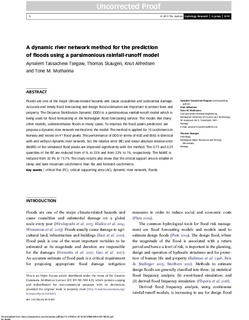| dc.contributor.author | Tsegaw, Aynalem Tassachew | |
| dc.contributor.author | Skaugen, Thomas | |
| dc.contributor.author | Alfredsen, Knut | |
| dc.contributor.author | Muthanna, Tone Merete | |
| dc.date.accessioned | 2019-08-30T11:10:09Z | |
| dc.date.available | 2019-08-30T11:10:09Z | |
| dc.date.created | 2019-08-26T23:30:58Z | |
| dc.date.issued | 2019 | |
| dc.identifier.citation | Hydrology Research. 2019, . | nb_NO |
| dc.identifier.issn | 1998-9563 | |
| dc.identifier.uri | http://hdl.handle.net/11250/2611841 | |
| dc.description.abstract | Floods are one of the major climate-related hazards and cause causalities and substantial damage. Accurate and timely flood forecasting and design flood estimation are important to protect lives and property. The Distance Distribution Dynamic (DDD) is a parsimonious rainfall-runoff model which is being used for flood forecasting at the Norwegian flood forecasting service. The model, like many other models, underestimates floods in many cases. To improve the flood peaks prediction, we propose a dynamic river network method into the model. The method is applied for 15 catchments in Norway and tested on 91 flood peaks. The performance of DDD in terms of KGE and BIAS is identical with and without dynamic river network, but the relative error (RE) and mean absolute relative error (MARE) of the simulated flood peaks are improved significantly with the method. The 0.75 and 0.25 quantiles of the RE are reduced from 41% to 23% and from 22% to 1%, respectively. The MARE is reduced from 32.9% to 15.7%. The study results also show that the critical support area is smaller in steep and bare mountain catchments than flat and forested catchments. | nb_NO |
| dc.language.iso | eng | nb_NO |
| dc.publisher | IWA Publishing | nb_NO |
| dc.rights | Attribution-NonCommercial-NoDerivatives 4.0 Internasjonal | * |
| dc.rights.uri | http://creativecommons.org/licenses/by-nc-nd/4.0/deed.no | * |
| dc.title | A dynamic river network method for the prediction of floods using a parsimonious rainfall-runoff model | nb_NO |
| dc.type | Journal article | nb_NO |
| dc.type | Peer reviewed | nb_NO |
| dc.description.version | publishedVersion | nb_NO |
| dc.source.pagenumber | 23 | nb_NO |
| dc.source.journal | Hydrology Research | nb_NO |
| dc.identifier.doi | 10.2166/nh.2019.003 | |
| dc.identifier.cristin | 1718902 | |
| dc.description.localcode | This is an Open Access article distributed under the terms of the Creative Commons Attribution Licence (CC BY-NC-ND 4.0), which permits copying and redistribution for non-commercial purposes with no derivatives, provided the original work is properly cited (http://creativecommons.org/ licenses/by-nc-nd/4.0/) 1 © 2019 The Authors Hydrology Research | in press | 2019 doi: 10.2166/nh.2019.003 | nb_NO |
| cristin.unitcode | 194,64,91,0 | |
| cristin.unitname | Institutt for bygg- og miljøteknikk | |
| cristin.ispublished | true | |
| cristin.fulltext | original | |
| cristin.qualitycode | 1 | |

